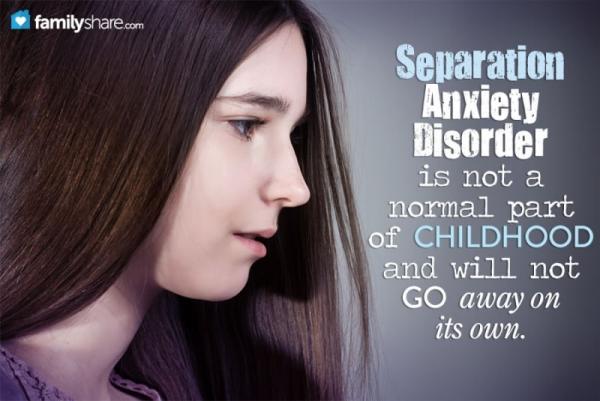
About a year ago, our daughter developed Separation Anxiety Disorder, SAD, a fear of physical separation from something or someone important to the child (in this case, me). It affects about 4-5 percent of children and adolescents and 1.3 percent of teens. SAD is not a normal part of childhood and will not go away on its own and is not the same as Separation Anxiety, a normal fear that starts about 7 months of age, is most common between 10 - 18 months and ends about 3 years old. SAD needs intervention, patience and endurance.
Symptoms
Separation Anxiety Disorder is diagnosed when the symptoms last four weeks or more to a child who is under 18-years-old, causes significant problems with some part of the child's life, is not part of another mental disorder and includes at least three of the following:
-
Fear something is going to happen to a loved one or themselves and may include fear of death and dying, plane or car accidents, mugging, burglary, kidnapping, monsters, the dark, animals, etc.
-
Nightmares about being separated.
-
Refusal to be away from the something or someone important.
-
Bed wetting.
-
Physical complaints may include: headaches, stomach ache or a general feeling of unwellness.
-
Some may complain they aren't loved and wish they were dead.
-
Temper tantrums, pleading or striking out when separation is imminent.
-
Social withdrawal.
A common symptom is the refusal to go to school which often results in poor academic performance. Up to 80 percent of children diagnosed with SAD show this symptom.
The symptoms may frustrate and cause conflict in the family as the child may take time away from other family members. In the case of our daughter, we spoke individually with her other siblings for their support as we helped her. The anxiety may also cause physical symptoms that need medical treatment.
What can you do?
-
Learn about SAD.
-
Relax. When you are anxious, your child is anxious.
-
Encourage him to talk about his feelings. He may already feel alone, so listen. Really listen.
-
Encourage her to continue activities outside the home. If she clings to you, have your partner drop her off or change the behavior by slowly distancing yourself after drop-off.
-
Maintain a regular schedule and tell him of any changes.
-
Keep household rules consistent for all your children and make sure the one showing SAD knows you understand her problem, but the rules must be followed consistently.
-
If he has refused to attend school, work with him to get him back as soon as possible. Partial days may be needed in the beginning.
-
Praise her. Even for the small things.
-
Help him toward independence by supporting his self-esteem and giving choices.
I believe it's important to teach independence. I'm there for advice, but I make my children ultimately responsible for their choices. I started this when they were little and now, as teens and adults, I see how "in control" they are with their lives compared to others their age.
Do not delay diagnosis and treatment if the symptoms are severe or if you have been unsuccessful with the above suggestions. Children with SAD are at a higher risk of developing other mental-health disorders, such as other anxiety disorders, depression, Panic Disorder and fear of having a panic attack in public- Agoraphobia.
Causes and diagnosis
The causes of SAD include environmental, genetic and biological factors. Fifty to 75 percent of SAD children are from homes of low economic status. Some are from close-knit families. Diagnosis involves your pediatrician and mental-healthcare professionals. They will search for medical causes, a history of anxiety in the family, a stressful event and the stress level of the mother during pregnancy.
Interviews are done separately to allow the child freedom to discuss the problem without you being part of the discussion. As with many children, our daughter didn't like hearing her problems discussed. Treatment should involve the entire family.
Treatment
In mild SAD cases, counseling is preferred. Medication is considered if the counseling is ineffective or other mental or medical conditions are present. Medication is also considered in severe cases. There are no medications specifically approved for SAD, but there are many available that help.
Behavioral modification is a common treatment. Small steps, with positive reinforcement, help the child gain confidence and lower anxiety. If it was really important for our daughter to attend an event, I would go. Each subsequent event, I left earlier and earlier, all the while congratulating her on staying.
Psychotherapy, or "talk therapy," helps the child replace the learned behavior of fear with positive reinforcement. Our daughter associated the fear with the events and each new threat of separation came with an increased level of anxiety. We lowered her level of anxiety by talking about the fear and teaching her deep breathing techniques to calm herself. Sometimes soothing music worked too.
Our daughter, with the help of her pediatrician, psychotherapy and following many of the steps above, is doing great. I can now leave her home with her siblings for short trips and she is much more comfortable attending infrequent social events. She never gave up regular events like youth night, dances and campouts. She did stop babysitting, staying or going out with friends and would have panic attacks, stomach aches and headaches when my husband and I planned long day trips or weekend outings.
What did we do? We took her along. We felt this was the best way to help her through the anxiety and she could see all was fine. We're still working on the babysitting, long day trips and weekends. I see fewer symptoms when we talk about them and can see weekends alone with my husband in the near future. Until then, we'll continue to support her through her anxiety.

